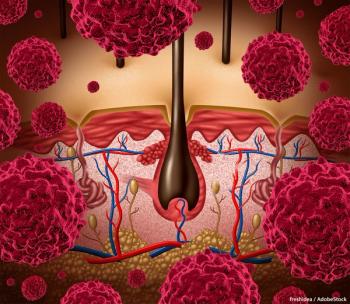
- ONCOLOGY Vol 22 No 14
- Volume 22
- Issue 14
The Absent-Minded Professor: An Unusual Complication of Melanoma
The University of Colorado Health Sciences Center holds weekly second opinion conferences focusing on cancer cases that represent most major cancer sites. Patients seen for second opinions are evaluated by an oncologist.
SECOND OPINION
Multidisciplinary Consultations on Challenging Cases
The University of Colorado Denver School of Medicine faculty holds weekly second opinion conferences focusing on cancer cases that represent most major cancer sites. Patients seen for second opinions are evaluated by an oncologic specialist. Their history, pathology, and radiographs are reviewed during the multidisciplinary conference, and then specific recommendations are made. These cases are usually challenging, and these conferences provide an outstanding educational opportunity for staff, fellows, and residents in training.
The second opinion conferences include actual cases from genitourinary, lung, melanoma, breast, neurosurgery, gastrointestinal, and medical oncology. On an occasional basis, ONCOLOGY will publish the more interesting case discussions and the resultant recommendations. We would appreciate your feedback; please contact us at
second.opinion@uchsc.edu
.
E. David Crawford, MD
Al Barqawi, MD
Guest Editors
University of Colorado Health Sciences Center
and Univeristy of Colorado Cancer Center
Denver, Colorado
The patient is a geology professor who was evaluated in our multidisciplinary cutaneous oncology clinic for a new diagnosis of malignant melanoma with subsequent development of metastatic disease and melanoma-associated retinopathy.
History
The patient initially presented to our clinic in 1998. At that time, he was a 57-year-old geologist with a history of extensive sun exposure who had a pigmented lesion biopsied from his right posterior auricular region. The pathology revealed a Clark’s level IV, 1.28-mm malignant melanoma. He subsequently underwent wide local excision with concurrent sentinel lymph node biopsy. The reexicison specimen revealed no residual melanoma, and three lymph nodes were removed, none of which showed any evidence of metastatic melanoma. After much discussion with the patient, he elected to enroll on an adjuvant clinical trial of interferon with or without tamoxifen. He was randomized to receive interferon alone. He received interferon at 3 million units subcutaneously three times a week for a total of 18 months. The patient tolerated this treatment well, with only fatigue as a complaint. He was then followed with close observation.
He did very well until May of 2002, when he began to complain of trouble with his vision. He reported yellow and white flashing lights and floaters. An optometrist initially evaluated him but found no etiology for these symptoms. Magnetic resonance imaging (MRI) of the brain was performed in June 2002 to further evaluate these symptoms. The scans showed no evidence of metastatic melanoma. Despite this initial negative workup, the patient continued to report worsening vision with persistent flashing lights as well as new symptoms of memory loss. He was therefore evaluated by ophthalmology. Because of his symptoms, there was concern about lymphoma as a possible cause, and therefore a vitreous biopsy was performed. The biopsy was interpreted as vitritis. The pathology revealed inflammatory white cells, no definitive pigment cells, and no lymphoma, and all cultures were negative.
Symptoms particularly worsened in September 2002, with progressive short-term memory loss and difficulty with verbal expression. The patient stated, “I am losing my mind.” A repeat MRI of the brain was performed, revealing a 5×4.4×4 cm left frontal hemorrhagic metastasis. He was admitted to neurosurgery and began therapy with steroids and antiepileptics. A left craniotomy with complete resection was performed, and the pathology was consistent with metastatic melanoma.
Further evaluation with imaging demonstrated mediastinal lymphadenopathy and only postoperative changes on brain MRI. In October 2002 the patient was enrolled on a clinical trial with EPO906A, an experimental epothilone.
FIGURE 1
Patient's Own Drawing of His Visual Symptoms
The patient’s short-term memory improved after treatment of the intracranial metastasis, but his visual complaints of flashing lights and floaters persisted. There was no improvement with systemic steroids. In December 2002, a retinal specialist evaluated him. At that time, the patient reported a bright yellow-white light that moved in and out of visual fields and faded within seconds. (
FIGURE 2
Right Eye Visual Field FIGURE 3
Left Eye Visual Field FIGURE 4
Funduscopic Exam
The patient was initiated on intravenous immunoglobulin (IVIg) monthly with stabilization and eventual improvement/resolution of his visual symptoms. He tolerated EPO906A very well and had a complete response to treatment with resolution of the mediastinal lymphadenopathy. The drug was eventually discontinued after 12 months of treatment. The IVIg is still required monthly. We have been unable to discontinue the IVIg, as his vision deteriorates with attempts to taper the dose or increase the treatment interval. He is currently still being followed by the multidisplinary team and shows no evidence of melanoma.
Discussion
Ophthalmology Review
Dr. Ragini Kudchadkar: Dr. Kimura, can you please review for us the ocular findings of melanoma-associated retinopathy (MAR)?
Dr. Alan Kimura: Patients with MAR often provide a history of photopsias and shimmering patches of color, and in this case shimmering yellow lights, the reappearance of which is a marker for too long an interval between IVIg treatments. Visual acuity is typically fairly well preserved. The largest review of patients with MAR documented a visual acuity of better then 20/60 in greater than 80% of patients.[1] Visual fields, however, are typically affected. Our patient showed constriction in visual fields with central scotomas. Though this type of presentation is common, there are many reports of patients with MAR that have normal visual fields. Thus, there are no specific visual field findings in MAR.
Funduscopic exam is generally normal in these patients. The largest series of patients in the literature demonstrates that approximately half have an essentially normal funduscopic exam.[1] In our patient, funduscopic exam was essentially within normal limits; however, occasional window defects were noted. These are not of clear significance. Other funduscopic findings that have been documented in the literature are optic nerve pallor, vessel attenuation, retinal pigment epithelium changes, and vitreous cells, although these finding are more characteristic of cancer-associated retinopathy (CAR), a paraneoplastic disease with autoantibodies directed against recoverin, a critical moiety of the visual cycle found in the photoreceptor.
Vitreous fluid analysis is only documented in a few patients with MAR. Among those patients (n = 10), most do show some cells with varying degrees of inflammation.[1] Melanoma cells are rarely seen, with only four documented cases throughout the literature.
FIGURE 5
Electroretinogram
The most important clinical diagnostic test is the electroretinogram (ERG). ERG is a measure of the electrical response of the retina to varying stimuli of light, under dark-adapted, then light-adapted states. The a-wave represents photoreceptor function, and the b-wave represents inner retinal function, reflecting either Mller cell or bipolar cell function. The classic finding of MAR, as demonstrated by our patient (
Pathophysiology
Dr. Kudchadkar: Dr. Gonzalez, can you discuss how the phenomenon of MAR develops?
Dr. Rene Gonzalez: MAR is essentially an autoimmune disease. Autoimmune disease involves molecular mimicry in which tumor antigens share similar epitopes to patient self-epitopes leading to a cross-reaction. Activated T and B cells respond to the foreign antigen, but they also react to the self-proteins because they share similar peptide sequences. This is what leads to the damage of self-tissue.[2] Although this general concept is likely true, there are many hypotheses as to the exact pathophysiology of MAR. Cancer-associated retinopathy may sometimes be related to the p53 gene mutation that is documented in many cancer cells. Mutated p53 produces the recoverin protein that is highly immunogenic and thus leads to antirecoverin antibody production.[3,4]
TABLE 1
Differential Diagnosis of Loss of B-Wave on ERG
This IgG antibody can penetrate the blood-retina barrier and bind to recoverin in the photoreceptor cells. This leads to increased phosphorylation of the molecule rhodopsin, which is involved in the phototransduction pathway, thus causing activation of the caspase-dependent apoptotic pathways and leading to photoreceptor cell death.[4]
Western blots have been used to analyze patients’ serum against normal donor retinal proteins.[5] They essentially show antiretinal IgG bands of activity. The antibodies are active against a number of proteins, not just recoverin. The antibodies have also been found against alpha-enolase, arrestin, carbonic anhydrase, TULP-1, photoreceptor cell–specific nuclear proteins, and heat shock protein 70.[5] The exact mechanism of photoreceptor death from these other antibodies is not clearly understood.
Some cases of MAR have no detectable antibodies by Western blot. However, many of these reports have been shown to have positive bipolar staining on normal human histologic slides and counterstaining for human immunoglobulin.[1,6,7] These findings have not been documented in all patients with no detectable antibodies by Western blot.
Histologically one can see a marked reduction in the density of bipolar cells and secondary trans-synaptic atrophy of ganglion cells.[8] This correlates well with the ERG findings and pathophysiology in MAR patients that were discussed earlier.
Overall, MAR is secondary to an antibody triggering death of bipolar cells. These antibodies can be variable, but treatment should be aimed at suppressing antibody production, removing the antibody from circulation, and/or blocking antibody action.
Melanoma and MAR
Dr. Kudchadkar: Dr. Lewis, does MAR develop in patients with a specific stage of melanoma?
Dr. Karl Lewis: There is no direct correlation between melanoma stage and the development of autoimmune retinopathy. However, in the largest series of patients reported, 28 of 62 had metastatic disease.[1] This suggests that more patients with advanced disease develop MAR. Given that it is thought that the antibodies develop secondarily to a cross-reaction between melanoma and self, one could theorize that the greater the amount of disease, the more likely one is to develop antibodies. However, this is yet to be proven.
Dr. Kudchadkar: Dr. Lewis, is the development of MAR related to prognosis?
Dr. Lewis: Given the rarity of MAR, it is very difficult to prove a relationship between the syndrome and prognosis. However, many have hypothesized that patients who develop autoimmune disease have a better prognosis compared to those who do not. This hypothesis is prevalent throughout many different cancer types, not just melanoma.
Authors of case reports involving spontaneous tumor regression have theorized that the patient’s immune system produced antibodies to destroy the cancer cells.[9-11] In lung cancer, antineural and antinuclear antibodies have been shown to be positive stage-independent prognostic factors.[12] This has been seen in gynecologic cancer patients as well, with autoantibodies to heat shock protein associated with improved survival.[13]
Approved therapies for melanoma include immune therapies such as interleukin-2 (Proleukin) and interferon. The fact that melanoma responds to immune therapy is further evidence that autoimmunity may be a favorable prognostic factor. Gogas et al evaluated melanoma patients treated with interferon alfa-2b (Intron A) and found that the appearance of autoantibodies or clinical manifestations of autoimmunity were associated with a statistically significant improvement in survival.[14] Overall, though, there is not enough evidence to prove MAR as a favorable prognostic factor in melanoma patients.
Dr. Gonzalez: If autoimmunity is hypothesized to be a good prognostic indicator, is there any indication that treatment of the retinopathy will decrease survival?
Dr. Lewis: Given the rarity of the disease, this is another question for which it is difficult to have a conclusive answer. If our patient has a clinical indication, the answer to your question is that the treatment of the retinopathy does not alter prognosis. Theoretically, immnunosuppression in melanoma would be harmful because of the role of immunity in this disease. There is no conclusive evidence that this is true in the treatment of MAR. However, if the visual symptoms are minimal and nonprogressive, one may want to avoid immunosuppression in light of the theoretical risks.
Maude Becker: What other cancers are associated with retinopathy?
Dr. Kudchadkar: In the mid-1970s, Hoyt first documented paraneoplastic-associated blindness as a remote complication of cancer.[15] Besides melanoma, other cancers associated with cases of retinopathy are those of the lung, ovaries, and colon. Though the presence of this phenomenon in cancer patients is rare, the diagnosis of autoimmune retinopathy should trigger a cancer workup in individual patients. Colonoscopy and chest-x-ray are indicated in patients diagnosed with autoimmune retinopathy but no prior history of cancer, especially in smokers or those greater than 50 years of age.
Treatment
Dr. Lewis: What are the treatment options for MAR?
Dr. Gonzalez: Treatment should be aimed at either blocking antibody function or decreasing antibody production. Most commonly, steroids are used initially, but alternatives like IVIg and plasmapheresis have also been used. There is no standard of care in the treatment of MAR.
Although steroids are commonly tried initially, most case reports do not document success with this treatment.[16] Six of seven patients in one case-series failed to respond to steroids alone.[1] Steroid doses are commonly about 1 mg/kg, with most case reports documenting the use of 60 to 80 mg of prednisone daily. One case report demonstrated an improvement with prednisone, but in this case steroids were combined with azathioprine, gabapentin, and plasmapheresis.
IVIg was used in our patient with great clinical success. However, now that we are years from his last documented evidence of disease, the patient still requires a monthly IVIg infusion. The reduction or even elimination of melanoma does not preclude progression of MAR, and this has been documented in other case reports as well.[17] If the infusion of IVIg is delayed, the patient’s visual symptoms return.
Plamsapheresis has been used on rare occasion for the treatment of MAR. However, one must also continue to suppress antibody production with another method, because pheresis will not stop production.
There is no definitive treatment for MAR, although steroids, IVIg, and plasmapheresis are the most common treatments documented in the literature. In theory, an anti–B-cell monoclonal antibody like rituximab (Rituxan) might be used; however, there are no reports of its use in MAR or any cancer-associated retinopathy.
Conclusions
Dr. Kudchadkar: Melanoma-associated retinopathy is a rare but distinct clinical entity that must be considered in any melanoma patient with visual symptoms, especially a flashing lights phenomenon. Visual fields are often affected and ERG can be diagnostic for this disease. If recurrent disease is not documented at the time of MAR diagnosis, one should consider repeat imaging in order to look for recurrent melanoma. The relationship of MAR to melanoma disease status and prognosis remains unclear. Treatment options include prednisone, plasmapheresis, and IVIg. Prednisone and plasmapheresis has had minimal success alone; however, case-reports of IVIg therapy, including this one, have shown some success.
Financial Disclosure:The authors have no significant financial interest or other relationship with the manufacturers of any products or providers of any service mentioned in this article.
References:
1. Keltner JL, Thirkill CE, Yip PT: CliniÂcal and immunologic characteristics of melanoma-associated retinopathy syndrome: Eleven new cases and a review of 51 previously published cases. J Neuroophthalmol 21:173-187, 2001.
2. Khan N, Huang JJ, Foster CS: Cancer associated retinopathy (CAR): An autoimmune-mediated paraneoplastic syndrome. Semin Ophthalmol 21:135-141, 2006.
3. McGinnis JF, Austin B, Klisk I, et al: Chromosomal assignment of the human gene for the cancer-associated retinopathy protein to chromosome 17p13.1. J Neurosci Res 40:165-168, 1995.
4. Maeda T, Maeda A, Maruyama I, et al: Mechanisms of photoreceptor cell death in cancer-associated retinopathy. Invest Ophthalmol Vis Sci 14:426-432, 2001.
5. Heckenlively JR, Ferreyra HA: Autoimmune retinopathy: A review and summary. Semin Immunopathol 30:127-134, 2008.
6. Milam AH, Saari JC, Jacobson SG, et al: Autoantibodies against retinal bipolar cells in cutaneous melanoma-associated retinopathy. Invest Ophthalmol Vis Sci 34:91-100, 1993.
7. Ladewig G, Reinhold U, Thirkill CE, et al: Incidence of antiretinal antibodies in melanoma: Screening of 77 serum samples from 51 patients with American Joint Committee on Cancer stage I-IV. Br J Dermatol 152:931-938, 2005.
8. Gittinger JW, Smith TW: Cutaneous melanoma-associated paraneoplastic retinopathy: Histopathologic observations. Am J Ophthalmol 127:612-614, 1999.
9. Morton DL, Foshag LJ, Hoon DS, et al: Prolongation of survival in metastatic melanoma after active specific immunotherapy with a new polyvalent melanoma vaccine. Ann Surg 216:463-480, 1992.
10. Ksander BR, Chen PW: Immunotherapy and gene therapy of uveal melanoma. Ophthalmol Clin North Am 12:183-196, 1999.
11. Davis TA, Maloney DG, Czerwinski DK, et al: Anti-idiotype antibodies can induce long-term complete remissions in non-Hodgkins lymphoma without eradicating the malignant clone. Blood 92:1184-1190, 1998.
12. Blates F, Klotz M, Huwer H, et al: Antineural and antinuclear autoantibodies are of prognostic relevance in non-small cell lung cancer. Ann Thorac Surg 69:254-258, 2000.
13. Korneeva I, Bongiovanni AM, Girotra M, et al: Serum antibodies to 27-kd heat shock protein in women with gynecologic cancers. Am J Obstet Gynecol 183:18-21, 2000.
14. Gogas H, Ioanniovich J, Dafni U, et al: Prognostic significance of autoimmunity during treatment of melanoma with interferon. N Engl J Med 354:709-718, 2006.
15. Sawyer RA, Selhourst JB, Zimmerman LE, et al: Blindness caused by photoreceptor degeneration as a remote effect of cancer. Am J Ophthalmol 81:606-613, 1976.
16. Jacobzone C, Cochard-Marianowski C, Kupfer I, et al: Corticosteroid treatment for melanoma-associated retinopathy. Arch Dermatol 140:1258-1261, 2004.
17. Subhadra C, Dudek A, Rath P, et al: Improvement in visual fields in a patient with melanoma-associated retinopathy treated with intravenous immunoglobulin. J Neuro-Ophthal-mol28:23-26, 2008.
Articles in this issue
almost 17 years ago
Inflammatory Breast Cancer: A Complex Diseasealmost 17 years ago
Defining the IBC Phenotypealmost 17 years ago
Acupuncturealmost 17 years ago
Two Orphan Drug Designations Granted for Reviroc in NHLalmost 17 years ago
NDA Submitted for Trabectedin to Treat Relapsed Ovarian Canceralmost 17 years ago
FDA Considers Update for Tanning Bed Labelsalmost 17 years ago
FDA Approves New Imaging System to Enhance Cervical Cancer DetectionNewsletter
Stay up to date on recent advances in the multidisciplinary approach to cancer.



















































































